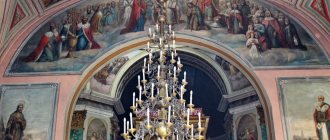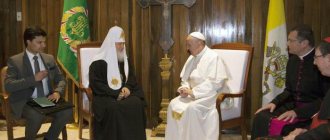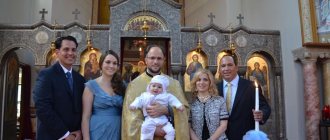A cardinal is the highest (after the Pope) clergyman of the Roman Catholic Church. In Latin: Cardinalis sanctæ romanæ Ecclesiæ (Cardinal of the Holy Roman Church). The history of cardinals goes back to seven ancient deacons chosen by the apostles and appointed to care for poor Christians.
The red color of the cardinals' clothes symbolizes loyalty to their pope and readiness to defend the throne at the cost of blood.
Under the Bishop of Rome, the tradition of electing seven privileged archdeacons was preserved for a long time, who soon concentrated in their hands enormous financial, administrative and even spiritual power, since they were subordinate only to the pope, and the popes themselves often depended on their closest and powerful subordinates (archdeacons), whom began to be respectfully called cardinals.
Archdeacons did not lose the title of cardinal even when they were promoted, ordained presbyters and bishops. Later, all cardinals began to be elevated to the dignity of bishop, but at the same time they receive a double (parallel) spiritual rank.
That is, those Catholic bishops who bear the title of cardinal, no matter in what part of the world they head their dioceses, are necessarily assigned to one of the parish churches of the city of Rome as a simple priest or even a deacon.
The traditional clothing of all clerics, as well as appointed ministers, is the cassock - a split dress with clasps to the floor. The color of the cardinal cassock is red.
The cardinal wears a wide red linen belt over the cassock, the end of which hangs down.
The cardinal's cap is one of the main symbols of the vestments of cardinals of the Roman Catholic Church. The red cap was first granted to cardinals by Pope Innocent IV in 1245. The red color symbolizes the readiness of its bearer to shed blood for the faith and for the Church.
Initially, only the cap symbolized the conferment of the rank of cardinal to a person, but later all the vestments of the cardinals became red and the cardinals began to be called Purple Bearers. The sayings “give a cardinal’s hat” or “receive a cardinal’s hat” meant elevating a cardinal to the dignity.
The Pope's wardrobe: from saturno to the “fisherman's ring”
The Holy Conclave continues to meet in the Vatican. In the coming days, the meeting of cardinals will present the new Pope to the world. It is logical that the pontiff, who has an impressive number of titles and is both the head of state and the Catholic Church, should have a lot of different outfits, many of which carry symbolic meaning.
Photo: Global Look Press
It is worth noting that Benedict XVI, who abdicated the Holy See, was one of the main reformers of papal fashion. He brought back the tradition of wearing the camauro, a winter hat made of camel's hair, as well as the red papal shoes, which were disliked by his predecessor John Paul II.
RBC tried to imagine what a papal wardrobe might look like. However, the real “closet” of the pontiff should be much larger, since some elements simply did not fit here - for example, the pluvial (kappa magna), stola, fanon, pallium, liturgical gloves and stockings, papal crozier, etc.
1. Tiara
A three-tiered crown in the shape of a bee's nest, topped with a small cross and having two flowing ribbons, worn by Popes from the beginning of the 14th century to 1965.
2. Camauro
Red hat, winter headdress of the Pope. Initially, kamauros were made from camel hair, but now they can also be made of velvet. The hat is trimmed with white ermine. The tradition of wearing a camauro was restored by Benedict XVI, who did not avoid comparisons with Santa Claus.
3. Pileolus (zucchetto)
The white priest's cap, the traditional headdress of the clergy of the Roman Catholic and Anglican churches. It arose out of the need to keep the tonsure of the clergy warm.
4. Cappello Romano (saturno)
Literally, “Roman hat” is a round headdress with wide brims and a hemispherical crown, worn by the Catholic clergy. The hat has no ceremonial significance and performs utilitarian functions. The second name - Saturn - was given to the dress due to its external resemblance to the planet Saturn.
5, 6. Mithra (infula)
The headdress of the highest Catholic clergy, a necessary element of liturgical vestments. In the Latin rite, there are three types of miter - simple (a white miter without decorations), gold (a miter made of gold-colored material or white silk with gold, silver or colored embroidery) and luxurious (a miter decorated with gold embroidery and precious stones).
7. Coat of arms of the papal throne
The crossed keys represent in symbolic form the keys of Simon Peter. The keys, gold and silver, represent the power to bind (silver) and loose (gold) given to the Church. The Triple Crown (tiara) represents the three functions of the Pope as "supreme shepherd", "supreme teacher" and "high priest". The golden cross on the ball (apple) crowning the tiara symbolizes the sovereignty of Jesus.
8. "The Fisherman's Ring"
Papal ring, designed to remind that the pontiff is the heir of the Apostle Peter, who was a fisherman. It depicts the apostle himself throwing a fishing net from a boat into the water.
9. Red cloak
Traditional outerwear of the Pope and cardinals, which has no liturgical significance. The cloaks of the Catholic clergy are made of light wool.
10. Dzimarra
A type of cassock, the main everyday vestment of Catholic bishops with a cape sewn onto the shoulders. Dad's is white.
11. Mozzetta
An element of the ecclesiastical vestments of Catholic and Anglican clergy, a short cape that previously had a small hood at the back, abolished by Paul VI. Dads wear two types of mozzetta - satin scarlet and velvet dark red, trimmed with ermine. During the Easter octave, a white mozzetta made of damask silk, also lined with ermine, is worn.
12. Alba
Long white liturgical vestment of Catholic and Lutheran clergy, belted with rope. Wearing it is mandatory for the priest performing the liturgy. Alba is sewn from thin linen, cotton or wool fabric. This clothing comes from the ancient Roman long shirt that was worn under the tunic.
13. Sutana
Long-sleeved outerwear of the Catholic clergy, worn outside of worship. The cassock has a stand-up collar, reaches the heels in length and is fastened with a number of buttons. The Pope's is white.
14. Fashya
Belt, detail of the church vestments of the Catholic clergy. The Pope wears a white moire sash over his cassock or dzimarra.
15. Perfume
Benedict XVI had a signature cologne, the scent of which was created by Silvana Casoli. It contains notes of verbena, lime tree and an unknown herb.
16. Papal red shoes
A historical item of clothing, a type of bishop's sandal. These shoes have been red throughout history. Traditionally, the Pope wore red shoes inside his residence, but Benedict XVI reinstated the use of red shoes outside.
Historically, there are three types of cardinal's hats
Galero is the oldest, flat, red hat with a wide brim, from which 15 tassels hang from the sides. The galero is the heraldic distinction of the rank of cardinal. Also called Galleys (plural) are other similar signs on the coats of arms of church dignitaries.
After long disputes with the German emperor, Pope Innocent IV fled to Lyon. On Christmas Day 1245, during the First Council of Lyon, the Pope appointed 13 new cardinals, presenting them with new red caps for the first time.
The galero comes from a simple pilgrim's hat with a wide brim. In church heraldry it is used with different numbers of tassels and in different colors.
At first, the Pope gave galeros to cardinals during their festive appointment. After death, the galero hangs on the cardinal's grave until the body turns to dust. This serves as a reminder of the frailty of earthly life.
Biretta - appeared approximately in the 15th-16th centuries. Today it is the main symbol of the cardinal's vestments. It is a quadrangular hat with three or four ridges at the top, topped with a pompom in the middle.
Typically, the Catholic biretta is black. The cardinal has the right to wear a red beret without a pompom. The shape and individual details of the biretta vary depending on the region and time of year.
Priests wore the biretta both outside of services and during certain moments of the liturgy.
Zucchetto is a small red kamilavka, the everyday headdress of cardinals. The traditional headdress of the clergy of the Roman Catholic Church, as well as the clergy of the Anglican Church. It arose out of practical necessity, namely in order to keep the tonsure of clergy representatives warm in the often cold, damp premises of churches.
Continued to exist as a traditional headdress. Consists of eight segments sewn together with a small tail on top. Externally, it is almost identical to the traditional Jewish headdress, the kippah.
All members of the Roman Catholic Church who are ordained are required to wear the pileolus (zuchetto). The color of the pileolus is determined by the rank of its owner. The Pope's pileolus is white, the cardinal's is red or scarlet, bishops, territorial abbots and territorial prelates are purple, priests and deacons wear a black pileolus.
Before the Second Vatican Council, Catholic vestments were distinguished by great pomp; after its end, the pomp decreased noticeably, but among traditionalist Catholics, magnificent liturgical vestments are preserved.
Liturgical vestments
For services in a cathedral or church, the headdress of the Pope is called a miter or infula. It is also found among Protestants and Orthodoxy. The traditional modern Catholic miter is not worn directly on the head, but on the pileolus and consists of two parts that converge at the top into a cone above the forehead and back of the head. Two ribbons are attached to the back, which are a symbol of the Old and New Testaments. The miter of the pontiff (he usually has more than one) is decorated with real precious stones and magnificent gold embroidery on a white background.
Interesting fact. The mitral valve of the human heart, which is located between the left ventricle and the left atrium, is so named because of its similar shape to the mitres. Andreas Vesalius noted the striking similarities between the two when performing anatomical dissections in the sixteenth century.
Getting to know the pontiff's headdresses
The Pope's headdress is far from alone. But we will start the description with the most famous - the tiara. Its exact origin is unknown. It appeared seven centuries ago. The tiara has the shape of a haystack, an egg or a bee's nest, whichever comparison you prefer. It was made of thick white fabric and richly decorated with gold embroidery and always two ribbons that flowed down the back of His Holiness.
The tiara was used when the new Pope took office. The enthronement ceremony required the laying of the triple crown. The last pope to support the ceremony was Paul VI in 1963, but a few weeks later, as a sign of humility, he handed over his tiara to the altar of St. Peter's Basilica. His successors have not been crowned since 1965. The Vatican does not comment on this matter. In 1968, it was given to the Cathedral of the Immaculate Conception in Washington. This was done for the purpose of displaying it and raising funds for the poorest segments of the population.
Why, if the Pope is a Roman Catholic, does he wear a Jewish cap?
The headdress of Catholic hierarchs (bishop, cardinal, pope) - piuska or pileolus - is not an analogue of a kippah. This has been a tradition since the Middle Ages, when monks and hierarchs needed to cover their tonsure from the scorching sun. Currently, piuski are worn, in addition to hierarchs (complete with a cassock), by monks of some traditional orders such as the Benedictines, Cistercians or Augustinians.
I once wrote about how the clothes of a Catholic priest appeared: thequestion.ru
Is it a sin for someone baptized in Orthodoxy to pray in a Catholic church, since both faiths belong to Christianity?
Absolutely forbidden. Orthodox Christians consider other faiths to be heretical, and praying with heretics is strictly prohibited. It is also forbidden to receive communion and confession from them.
Are Armenians Christians or Catholics?
Both. Catholics = Christians .
If your question is “are Armenians Catholics or Orthodox,” then again, it’s both. There is the Armenian Apostolic Church, there is the Armenian Catholic Church.
- Catholics,
- Orthodox,
- Anglicans,
- Lutherans,
- various Protestants.
It is clearly seen that Catholics = Christians (see the crucifix?), and that there are Armenian Catholics:
1 2 · Good answer
How can an Orthodox shock a Catholic and vice versa?
Funny. Would you like to know what “holiness” is, or what “holy water” is?
Holiness is literally dead.
Holiness is a posthumous assessment of a person’s activity in the field of religious worship, adopted collegiately (by voting).
That is why everything associated with such activities is called “holy”.
“Holy water” is “dead water” from Russian fairy tales. Even microorganisms do not live in this water. “Holy water” can disinfect wounds, but you cannot drink or splash it on a living person. This kind of thing kills the mind and turns it into an obedient, Christianized beast.
Christianity is a perverted cult of death, with kissing the bones of the dead, playing cannibalism and worshiping an idol with sexual problems, for which he was hung in the pillory.
Can Catholics cross themselves from right to left? Which Catholic Church is active in South Tyrol?
It is absolutely acceptable and normal for Catholics to address the Holy Spirit from right to left. But when turning from left to right, we immediately begin to talk about sin, unrighteous thoughts and pride. So at the moment in South Tyrol we turn to Saints Peter and Paul, who stood in the bastion, to protect us from the enemy. Before this, we read a prayer for intercession before God. Next, Catholics are baptized from right to left and make peace with the world. They sing the morning song "Nation First", which is not considered Catholic. This is considered a folk song and does not require any explanation. And whenever we talk about sacrifices and prayers for peace, we already know that peace is essentially a holy communion, and we should not feel any qualms about using our speech in terms of the material world. We have the same right to speak our own language as everyone else. We do not have a monopoly on any religion. And if one Catholic organization says the same words as we do, we should not feel offended.








